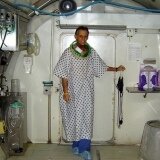Blast Injury and Hyperbaric Oxygenation
Featured article. Page 2.
Acute Brain and Cardio-Respiratory Dysfunction After Blast/Blunt Injuries: The Life-Preserving Effects of Hyperbaric Oxygenation
Gennady G. Rogatsky and Avraham Mayevsky
The Mina & Everard Goodman Faculty of Life Sciences and the Leslie and Susan Gonda Multidisciplinary Brain Research Center, Bar-Ilan University, Ramat-Gan 52900, Israel
III. PATHOPHYSIOLOGICAL CHANGES
As mentioned above, blast injury (especially its severe forms) produce multi-component damage and, correspondingly, many aspects of the damage pathophysiology require further clarification. The present review will focus on the data regarding the pathophysiology of chest and head injury, as well as the pathophysiological manifestations in the cerebral and cardio-respiratory system in response to blast injury. This aspect is of special importance when assessing the viability and adequacy of rescue measures for victims of severe forms of blast injury.
A. Experimental Animal Studies
1. Circulatory-Respiratory Changes
Experimental work on animals subjected to a thoracic blast has demonstrated a reflex triad of apnea, bradycardia and hypotension.87 This triad effect is thought to be mediated by pulmonary afferent C-fiber receptors located in alveolar interstitial spaces close to pulmonary capillaries. An increase in pulmonary interstitial pressure or volume, due to pulmonary hemorrhage and edema, could distort and therefore activate the pulmonary C-fibers. However, this triad is not shown in animals undergoing abdominal blast exposure.87 Therefore, it is likely that such cardio-respiratory responses are multi-factorial, and that the additional conventional injuries associated with hemorrhage are likely to alter the physiological picture.85 It has been demonstrated that, under the primary, secondary and tertiary blast mechanisms, organs of the chest cavity are subjected to blunt chest trauma. As follows from the above-cited literature, such a trauma must be considered basic for the majority of uncomplicated primary blast injury cases.
Animal studies have produced important information on the sequence of ventilation and oxygenation problems resulting from primary blast injury.160 In the studies on sheep,58,59 dogs,39,58 and pigs,48 the animals rapidly became hypoxemic after blast injury. Their immediate response to the blast was apnea, which lasted 30-120 seconds.43,48 In animals, the apnea was often accompanied by bradycardia. Both of these responses can be ablated by vagotomy.43 Within minutes of the injury, the animals’ respiratory rate greatly increased over the baseline value and, although the tidal volume (the average volume of gas inspired with each breath) was decreased, the minute volume (the mean volume of inspired gas per minute) was increased.44
The increase in the central ventilatory drive may have been caused by either pain or pulmonary mechano-receptors, and it resulted not only in an increase in oxygen consumption, but also in a decrease in the level of arterial pCO2.43 For example, twenty-seven of twenty-nine sheep that had pure PBI but were not in hypovolemic shock had arterial pCO2 levels that were less than 40 mm Hg.59 These animal studies also found that the magnitude of shunting (an index of oxygen efficiency that measures the amount of blood passing through the lungs without being oxygenated) was directly related to the degree of lung hemorrhage.58
Although there may be an improvement within 24-48 hours, a measurable decrement in pulmonary gas exchange may last for weeks. However, in other observations of blunt chest injury in dogs, arterial hypoxemia progressed during several days, in a number of cases with a fatal outcome.175
The animals’ cardiovascular responses to the blast were less dramatic. For example, within a few hours of injury, the cardiac output in dogs increased only about 15% because of an increase in both the heart rate and stroke volume.230 These parameters returned to a near-baseline level within 24 hours. Statistically insignificant changes in the heart rate, CO level and gas levels in arterial blood were also noted in pigs within the first 120 min after the trauma by Axelsson et al.14 However, other experimental works demonstrated principally different results.
Thus, according to Januszkiewicz et al.,113 Dodd et al.,68 Irwin et al.,107 during the first 3 hours after reproducing the blast chest trauma model, there were observed a significant reduction in cardiac output (CO), stroke volume index (SVI) and PaO2 levels, that were considered to be either a result of myocardial contusion68 or air embolzation, or of cardiac dysfunction.8,107,124
The steep decrease in PaO2 in rats, caused by the blast pressure wave, was due to an increase of the portion of intra-pulmonary venous blood admixture in the arterial blood as a result of intra-pulmonary hemorrhage.107,108 These results for cardio-respiratory function after blast trauma, fully correspond to the earlier reported data regarding cardio-respiratory function in dogs after blunt chest injury.174,175 In animals with a fatal outcome of the chest trauma, the progressing decrease in myocardium contractibility (an increase in the end-diastolic pressure in the ventricle) was accompanied by a decline in PaO2 (Fig. 1).
The parameters showed an increasing negative correlation, especially marked in the later stages of post-traumatic syndrome. The state of myocardium contractibility in these cases, in the present author’s opinion, is a key factor in the development of acute oxygen deficiency after blunt chest trauma. This conclusion was further corroborated by clinical investigations168 as well as by experimental studies.142 It should be assumed that, under blast and blunt chest traumas, there may occur not only markedly common morphological manifestations,49,61,125,196,204 but, judging from the presented data,107,142,164,168,175 also common pathophysiological mechanisms in the development of their characteristic acute cardio-pulmonary disorders. As shown by Rady et al.,168 early depression of cardiac function is associated with poor outcome in patients with thoracic blunt trauma, and measurements of oxygen transport variables may influence resuscitation. In the absence of analogous investigations in blast injury victims, this conclusion, obtained in studying the mechanisms of blunt chest trauma, has great added value.
As follows from the literature analysis, among the many works employing the term “hypoxia” to pathophysiologically define conditions caused by blast injury12,36,46,73,80,124,188,198,203,215 and others, in fact only the works of Irwin et al.107 and Dodd et al.68 presented real premises for a scientifically substantiated use of this term, since the authors had at their disposal the methods and conditions for the actual measurements of oxygen transport values. Indeed, the results of these studies, along with other investigations (clinical, functional, morphological, electro-physiological, roentgenological), implicate hypoxia as a most likely and life-threatening complication of blast injury, especially in its severe forms. This conclusion becomes further supported when taking into account the role of CNS impairment in the development of functional damage associated with blast injury.










